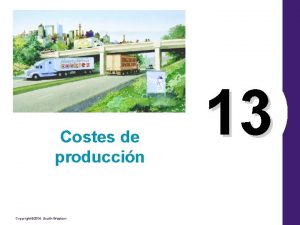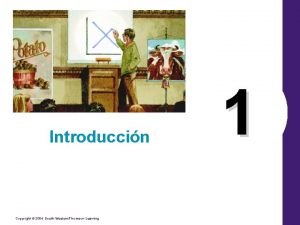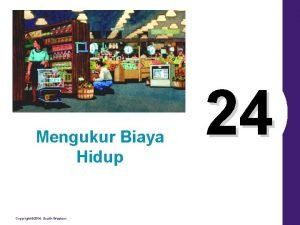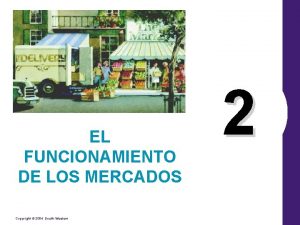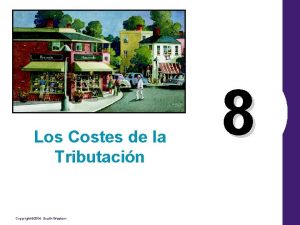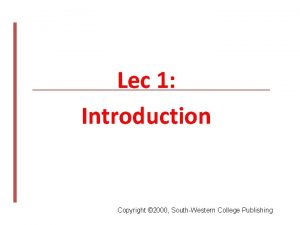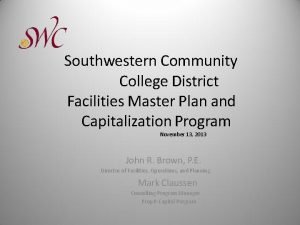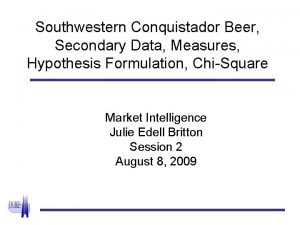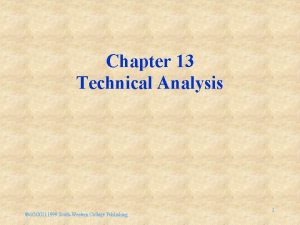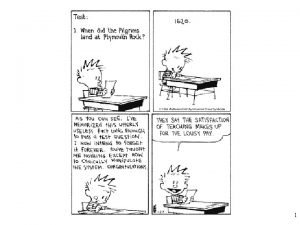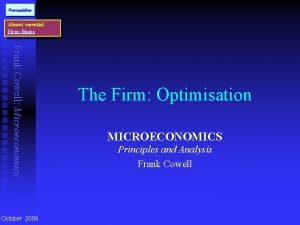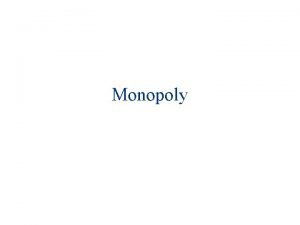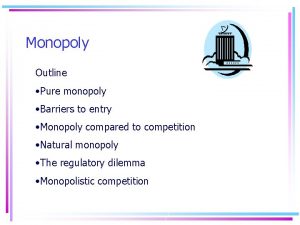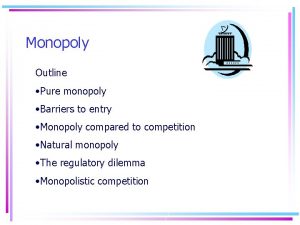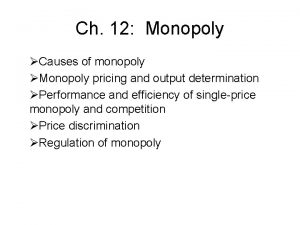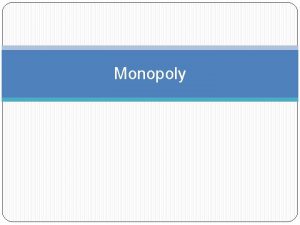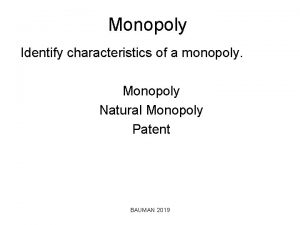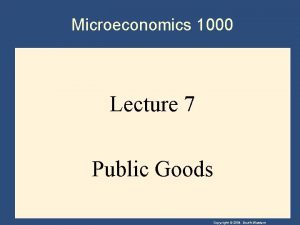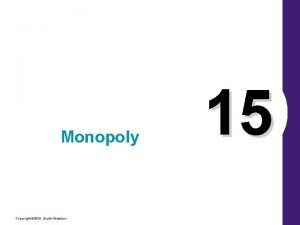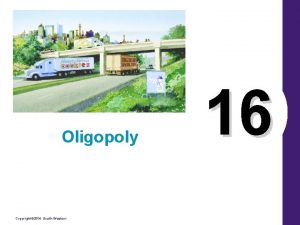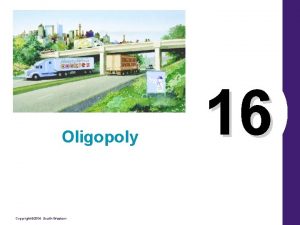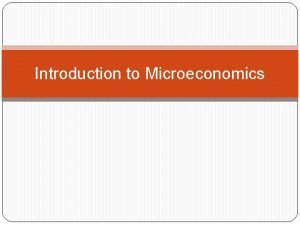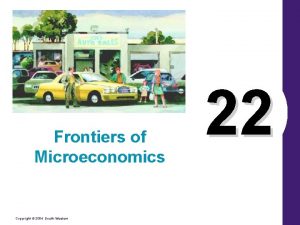Microeconomics 1000 Lecture 11 Monopoly Copyright 2004 SouthWestern










































- Slides: 42

Microeconomics 1000 Lecture 11 Monopoly Copyright © 2004 South-Western

Monopoly • A firm is considered a monopoly if. . . • it is the sole seller of its product. • its product does not have close substitutes • there are many potential consumers of the product, each of whom demands a quantity which is a small fraction of the total quantity produced and sold • In those circumstances, it seems natural to posit that the monopoly firm is the price maker while the consumers are price taker • In other words, the price is set by the firm Copyright © 2004 South-Western

WHY MONOPOLIES ARISE • This will be the subject of Lecture 12 • Today we shall focus on how monopolies make production and pricing decisions, and how this affects the amount of trade in a market Copyright © 2004 South-Western

Profit • In theory, things are very simple profit = total revenue – total costs • In practice, it may be quite difficult to measure firm profit on yearly (say) basis • Some costs are long run costs and a share must be imputed to any given year • The value of the stocks must be estimated • Some revenues may be uncertain (e. g. , some buyers may be insolvent) Copyright © 2004 South-Western

Profit • Copyright © 2004 South-Western

Example • Consider a monopoly who faces a downward sloping demand curve (to fix ideas, we shall use the same numerical example as in Lecture 1) and can produce any amount of the good at a constant unit cost equal to 3 Copyright © 2004 South-Western

price v. A 20 v. B 12 v. C 8 v. D 3 O 1 2 3 4 quantity Copyright © 2004 South-Western

price quantity total revenue total cost profit > 20 0 0 20 1 20 3 17 <20 & >12 1 <20 3 <17 12 2 24 6 18 8 3 24 9 15 3 4 12 12 0 Copyright © 2004 South-Western

Total revenue • Notice that when the quantity sold increases from 2 to 3, the total revenue stays constant at 24 • The reason is that to sell 3 units rather than 2, the monopoly must reduce the price from 12 to 8 • While the fact that the total revenue does not increase is a special property of this numerical example, the fact that the revenue increases by less than the price is a general property Copyright © 2004 South-Western

Intuition • When a monopoly increases the amount it sells, there are two effects on total revenue (p q) • The output effect—more output is sold, so q is higher. • The price effect—price falls, so p is lower. • In general, either effect may prevail • However, only if the price effect vanished (that is, if the price stayed constant as more units are sold) would the increase in total revenue equal the price Copyright © 2004 South-Western

Marginal revenue • The marginal revenue is the change in total revenue as one more unit is sold • In general marginal revenue = price + – (change in price) × (initial quantity) • It follows that in general marginal revenue < price • Marginal revenue can even be negative Copyright © 2004 South-Western

Intuition • A monopolist’s marginal revenue is always less than the price of its good. • The demand curve is downward sloping. • When a monopoly drops the price to sell one more unit, the revenue received from previously sold units also decreases. Copyright © 2004 South-Western

Figure 1 Marginal revenue Demand Revenue When the demand curve is a straight line… …the marginal revenue curve is also a straight line, and its (negative) slope is twice as large as that of the demand curve Demand Marginal revenue 0 Quantity Copyright © 2004 South-Western

price quantity marginal revenue marginal cost profit 20 1 20 3 17 12 2 4 3 18 8 3 0 3 15 3 4 - 12 3 0 Copyright © 2004 South-Western

Why rational agents think at the margin • If your choice of a certain variable (such as how much to produce, or the price at which to supply the market) is made with the objective of maximising another variable (such as profit), you must look at the effect of a unit (marginal) change in the variable you control on the variable you wish to maximise • For example, starting from q = 1 you ask what is the effect of moving to q = 2 Copyright © 2004 South-Western

Marginal revenue and unit cost • Copyright © 2004 South-Western

Profit Maximization • Copyright © 2004 South-Western

Figure 2 Profit Maximization for a Monopoly Costs and Revenue 2. . and then the demand curve shows the price consistent with this quantity. B Monopoly price A 1. The intersection of the marginal-revenue curve and the unit-cost curve determines the profit-maximizing quantity. . . Unit cost Demand Marginal revenue 0 Q QMAX Q Quantity Copyright © 2004 South-Western

Figure 3 The Monopolist’s Profit Costs and Revenue Monopoly E price D B C Unit cost Demand Marginal revenue 0 QMAX Quantity Copyright © 2004 South-Western

A Monopolist’s Profit • Note • Quantity on the intersection of unit cost and MR. • Price is given by the point on the demand curve on the vertical of this intersection. • The monopolist will receive economic profits as long as price is greater than unit cost. Copyright © 2004 South-Western

Figure 4 The Market for Drugs Costs and Revenue Price during patent life Price after patent expires Marginal cost Marginal revenue 0 Monopoly quantity Competitive quantity Demand Quantity Copyright © 2004 South-Western

THE WELFARE COST OF MONOPOLY • The monopoly charges a price above the marginal cost. • From the standpoint of consumers, this high price makes monopoly undesirable. • However, from the standpoint of the owners of the firm, the high price makes monopoly very desirable. Copyright © 2004 South-Western

Figure 5 The Efficient Level of Output Price Value to buyers Unit cost Value to buyers Demand (value to buyers) Quantity 0 Value to buyers is greater than cost to seller. Value to buyers is less than cost to seller. Efficient quantity Copyright © 2004 South-Western

The Deadweight Loss • Because a monopoly sets its price above marginal cost, it places a wedge between the consumer’s willingness to pay and the producer’s cost. • This wedge causes the quantity sold to fall short of the social optimum. Copyright © 2004 South-Western

Figure 6 The Inefficiency of Monopoly Price Deadweight loss Monopoly price Unit cost Marginal revenue 0 Monopoly quantity Efficient quantity Demand Quantity Copyright © 2004 South-Western

The Deadweight Loss • The Inefficiency of Monopoly • The monopolist produces less than the socially efficient quantity of output. • In our original numerical example, the deadweight loss is associated with the fact that consumer C is not served while it would be efficient to serve him. The deadweight loss is 5 • In general, many consumers may not be served even if their w. t. p. ’s are greater than the unit cost Copyright © 2004 South-Western

PRICE DISCRIMINATION • Price discrimination is the business practice of selling the same good at different prices to different customers, even though the costs for producing for the two customers are the same. Copyright © 2004 South-Western

PRICE DISCRIMINATION • Price discrimination is not possible in the presence of a secondary market in which consumers can exchange the good purchased from the monopolist • It is also impeded by the seller’s incomplete information about w. t. p. ’s Copyright © 2004 South-Western

PRICE DISCRIMINATION • Two important effects of price discrimination: • It can increase the monopolist’s profits. • It can reduce deadweight loss. Copyright © 2004 South-Western

Perfect Price Discrimination • Perfect price discrimination refers to the situation when the monopolist knows exactly the w. t. p. of each customer and can charge each customer a different price • However, typically the consumer’s w. t. p. is his or her private information Copyright © 2004 South-Western

Figure 7 Welfare with and without Price Discrimination (a) Monopolist with Single Price Consumer surplus Monopoly price Deadweight loss Profit Marginal cost Marginal revenue 0 Quantity sold Demand Quantity Copyright © 2004 South-Western

Figure 8 Welfare with and without Price Discrimination (b) Monopolist with Perfect Price Discrimination Price Profit Marginal cost Demand 0 Quantity sold Quantity Copyright © 2004 South-Western

PRICE DISCRIMINATION • Examples of Price Discrimination • • Movie tickets Airline prices Versioning Quantity discounts Copyright © 2004 South-Western

What is monopoly power? • Monopoly power is the monopoly’s ability to profitably charge price above unit cost • This determines both the profitability of the monopoly and the magnitude of the deadweight loss that it imposes on society • The assessment of monopoly power is also a preliminary, key step in the implementation of antitrust policy Copyright © 2004 South-Western

Total Revenue and the Price Elasticity of Demand • Total revenue is the amount paid by buyers and received by sellers of a good. • Computed as the price of the good times the quantity sold. TR = p x q Copyright © 2004 South-Western

Marginal revenue and elasticity • Copyright © 2004 South-Western

Lerner’s index of monopoly power • Copyright © 2004 South-Western

Lerner index • Copyright © 2004 South-Western

Summary • A monopoly is a firm that is the sole seller in its market. • It faces a downward-sloping demand curve for its product. • A monopoly’s marginal revenue is always below the price of its good. Copyright © 2004 South-Western

Summary • A monopoly maximizes profit by producing the quantity at which marginal cost and marginal revenue are equal. • The price exceeds the monopoly’s marginal revenue, so its price exceeds marginal cost. • A monopolist’s profit-maximizing level of output is below the level that maximizes the sum of consumer and producer surplus. • A monopoly causes deadweight losses. Copyright © 2004 South-Western

Summary • Monopolists can raise their profits by charging different prices to different buyers based on their willingness to pay. • Price discrimination typically increases profits, it can also raise economic welfare and lessen deadweight losses. Copyright © 2004 South-Western

Conclusions • One can often define a market so narrowly that a firm is a monopoly (e. g. Raleigh has the monopoly of Raleigh bicycles) • However, that implies that the product will have so many and so close substitutes that the elasticity of demand is very large, and hence the firm’s monopoly power is negligible • Only monopolies for which there are no close substitutes (and hence the elasticity of demand is relatively small) have real market power Copyright © 2004 South-Western
 Intermediate microeconomics lecture notes
Intermediate microeconomics lecture notes Curva de oferta a largo plazo de una empresa competitiva
Curva de oferta a largo plazo de una empresa competitiva Légende amérindienne sirop d érable
Légende amérindienne sirop d érable Copyright 2004
Copyright 2004 Copyright 2004
Copyright 2004 Copyright 2004
Copyright 2004 Mengukur biaya hidup
Mengukur biaya hidup Copyright 2004
Copyright 2004 Copyright 2004
Copyright 2004 Copyright 2004
Copyright 2004 Copyright 2004
Copyright 2004 Nesova ravnoteza
Nesova ravnoteza Externalidades positivas
Externalidades positivas 01:640:244 lecture notes - lecture 15: plat, idah, farad
01:640:244 lecture notes - lecture 15: plat, idah, farad Southwestern province
Southwestern province Southwestern college cincinnati ohio
Southwestern college cincinnati ohio Kappa alpha psi southwestern province
Kappa alpha psi southwestern province Kappa alpha psi southwestern province
Kappa alpha psi southwestern province South-western college publishing
South-western college publishing Southwestern community college
Southwestern community college Symplicity rutgers
Symplicity rutgers Conquistador beer
Conquistador beer Southwestern educational publishing
Southwestern educational publishing Southwest province kappa psi
Southwest province kappa psi Thomson southwestern
Thomson southwestern Kennedy krieger
Kennedy krieger Kappa alpha psi k
Kappa alpha psi k Southwestern college publishing
Southwestern college publishing Southwestern college publishing
Southwestern college publishing Catherine carpenter southwestern
Catherine carpenter southwestern Swp kappa alpha psi
Swp kappa alpha psi Cowell microeconomics
Cowell microeconomics Objective of microeconomics
Objective of microeconomics System of national accounting
System of national accounting Intermediate microeconomics notes
Intermediate microeconomics notes Cowell microeconomics
Cowell microeconomics Ap microeconomics unit 1 basic economic concepts
Ap microeconomics unit 1 basic economic concepts Microeconomics examples
Microeconomics examples Almost essential
Almost essential Macro vs micro definition
Macro vs micro definition Almost essential
Almost essential Microeconomics
Microeconomics Microeconomics chapter 12
Microeconomics chapter 12



